Enhancing Hydraulic Efficiency:
The Evolution of Wanner™
Hydra-Cell®
Pumps to Hydra-Cell Pro Series
The Wanner™ Hydra-Cell® Pro Series is an innovation within the hydraulic end of Wanner Hydra-Cell pumps which improves its volumetric efficiency. This article is meant to supplement Wanner technical bulletin TB0083 by including additional illustrations along with a historical summary of the evolutionary journey from Hydra-Cell to Kel-Cell and now to Hydra-Cell Pro.
Those of us who have been associated with Wanner Engineering for a long time have witnessed the continuous and impressive growth of their Hydra-Cell sealless positive displacement pump.
William Wanner Sr was issued the first patent for the Hydra-Cell in 1972
and his son William Wanner Jr established Wanner Engineering Inc in 1973.
Thirty years later, Kel-Cell Diaphragm Position Control Technology was
patented, an enhancement to the original Hydra-Cell to enable the pumps
diaphragms to survive cavitation due to poor inlet conditions, thereby
significantly increasing process reliability. Twenty years after, at Wanner
Engineering’s 50th anniversary as an innovative pump manufacturer, the
patented Hydra-Cell Pro is announced.
What is the Hydra-Cell?
It is a dynamic, fast-acting
valve which creates a hydraulic piston that self-adjusts to the pressure it
is pumping against. The hydraulic piston acts upon a diaphragm to increase
and decrease the volume of a pump chamber, which is the pumping action of a
positive displacement pump. Hydra-Cell pumps, having similar flow rate and
pressure capabilities to piston and plunger style pumps, essentially
eliminated the dynamic seal (packing and mechanical seals) and replaced it
with a static seal (diaphragm); thereby eliminating a significant
contributor to fugitive emissions and pump failures. Read our comprehensive
article comparing Hydra-Cell Pro pumps to piston and plunger pumps.
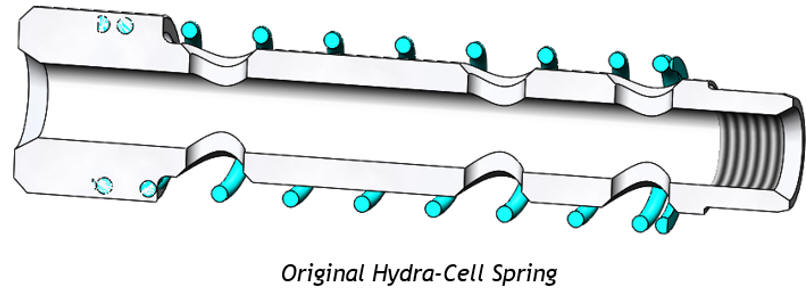
The Kel-Cell Innovation
Hydra-Cell valves contain a
spring used to provide “bias pressure” to aid with creation of the hydraulic
piston. The Kel-Cell innovation replaced the original long spring with a
shorter and stiffer version which prevented the Hydra-Cell from over fill
conditions due to inlet cavitation conditions that damaged the original
Hydra-Cell pump diaphragms. This new spring design prevented the over fill
condition although also required the addition of a groove within the pumps
cylinder housing to aid with priming capability.
Hydra-Cell Pro
The latest version of the Hydra-Cell
is referred to as “Hydra-Cell Pro” and this time two springs are used
instead of just one. The dual spring approach eliminates the need to have a
grooved cylinder housing, which consequently increases the hydraulic
efficiency of the hydraulic piston and the position control is maintained
such that cavitation resulting from a partially or fully restricted inlet
does not result in immediate damage to the pump diaphragms. Hydra-Cell Pro
pumps are truly sealless, positive displacement pumps, designed to dry-prime
and to survive dry running operation or violent cavitation conditions. Of
course, the non-dynamic diaphragm seal enables these pumps to process
liquids which wear and leak though conventional cups, packing and seals used
by other positive displacement pump designs.
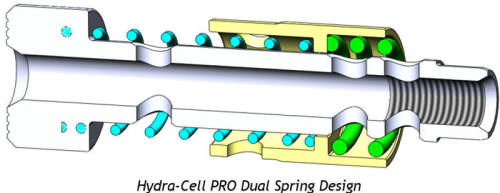
Additional Features of Hydra-Cell Pro pumps
Previously available as an optional feature, Hydra-Cell Pro pumps have valve
plates with an optimized valve pocket. This refers to the geometry of the
pump chamber side of the valve plate which is now machined to more closely
match the shape of the extended diaphragm to minimizing excess space.
Benefits include reduced accumulation of particulates within the pump
chamber and increased volumetric efficiency.
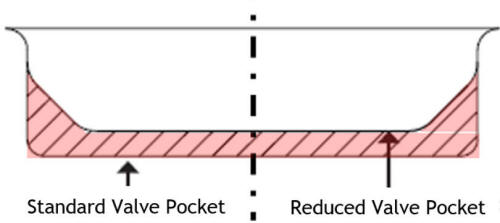
Volumetric Efficiency
This efficiency refers to the
volume of oil which makes-up the hydraulic piston; the goal is to minimize
this volume to maximize volumetric efficiency. Prior to Hydra-Cell PRO which
is also referred to as ADPC (Advanced Diaphragm Position Control), the
hydraulic efficiency was 85-95% at full speed (pump shaft RPM) and pressure.
When operated at full speed and lower pressures the efficiency increased to
99%, but when operated at lower speeds at full pressure efficiency could
drop to <50%. Hydra-Cell PRO pumps have significantly increased efficiencies
for the lower speed, higher pressure region of operation. Whereas there is
about a 2% improvement in efficiency at full speed and pressure, at low
speeds and full pressure efficiency is now within that 85-95% range.
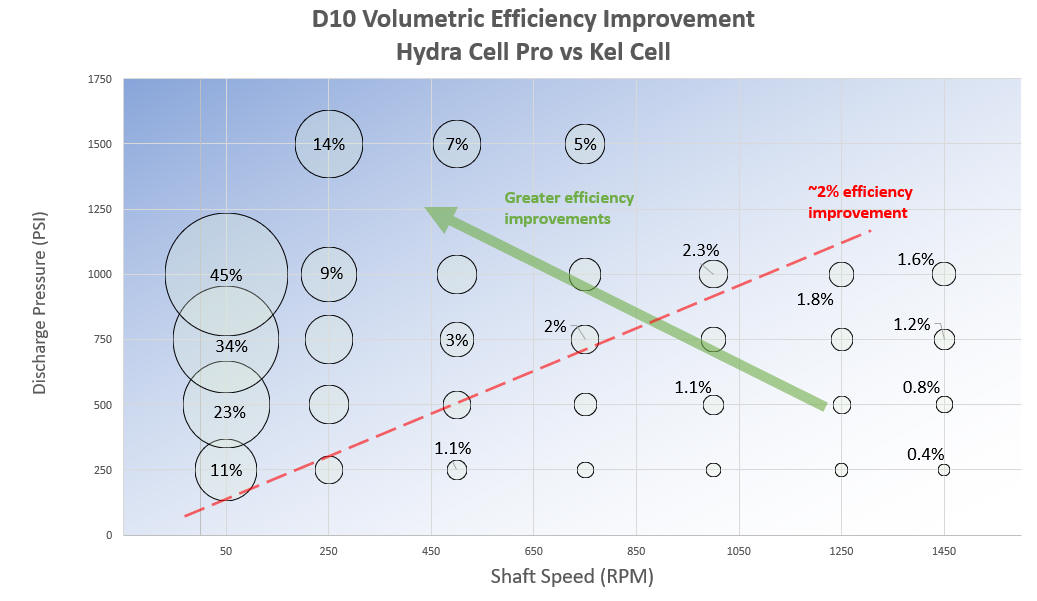
This increase in efficiency is most notable in low flow rate metering
applications, essentially boosting our flow rate at a given RPM when
compared to the previous Kel-Cell design.
Summary of Changed Components
-
The cylinder housing will no longer contain grooves and will be stamped “PG”.
-
Hydra-Cell Pro pistons can be retrofit into “classic” and “Kel-Cell” generation Hydra-Cell pumps, however the internal components of the various Hydra-Cell designs are not interchangeable, thus upgrading to the Pro version requires swapping-out the complete piston assembly.
-
The valve plate will have a reduced pocket (the cavity which forms the pump chamber) and this valve plate can be retrofit to any existing Hydra-Cell pump.
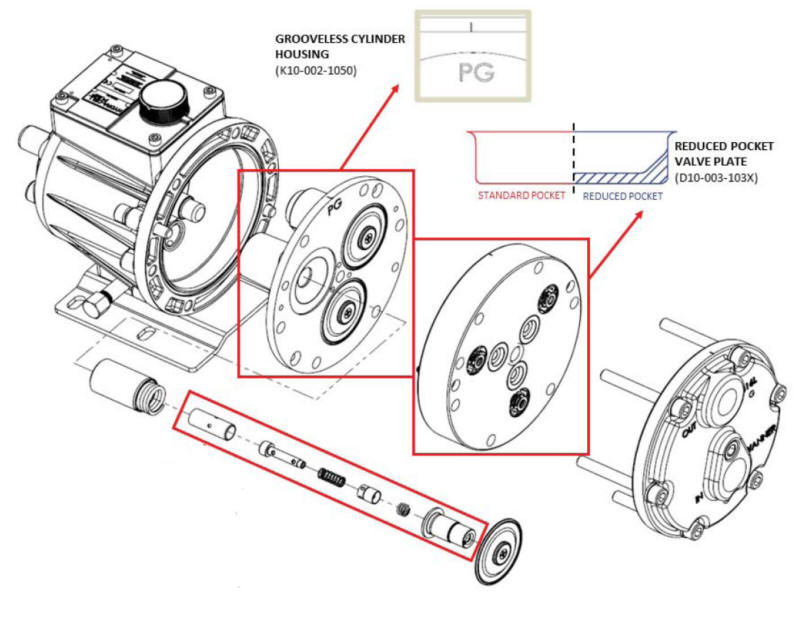
The Hydra-Cell Pro innovation has not yet been engineered for the smaller capacity 20, 03 and 04 series pumps as of early 2024 and thus only applies to the 10, 12, 15, 17, 25, 35 and 66 capacity pumps along with the Hydra-Cell Metering Solutions versions of these pump models.
Summary of Wanner Hydra-Cell Pro Advantages
-
No mechanical seals, packing, or cups to leak, wear or replace
-
Minimizes maintenance, downtime and environmental impact
-
Wide, controllable flow range independent of discharge pressure from minimum to maximum RPM
-
Metering accuracy exceeding API 675 performance
-
-
Patented ADPC (Advance Diaphragm Position Control)
-
Protects the diaphragm from adverse suction conditions
-
Can run dry indefinably without damage to the pump
-
-
Sealless design and horizontal disk check valves
-
Handles slurries, viscous, corrosive, particulates and abrasive fluids
-
Eliminates pump and piping damage caused by pulsations
-
-
Reduced total cost of ownership
-
Acquisition, operation, service, maintenance and energy cost
-
-
85% to 99% Performance efficiency over the operating range
-
Compact, lighter weight design for application flexibility
-
Related Articles
-
Comparison of Hydra-Cell Pro metering pump to an External gear pump
-
Comparison of Hydra-Cell Pro pump to AODD (Air Operated Double Diaphragm pump)
-
Comparison of Hydra-Cell Pro pump to Piston and Plunger pumps
-
Comparison of Hydra-Cell Pro pump to Progressive Cavity Pumps
-
Hydra-Oil: role and importance of oil used in Hydra-Cell Pro pumps
-
Pumping difficult to handle liquids with Hydra-Cell Pro Pumps
-
Relationship of flow rate and pressure for positive displacement and centrifugal pumps




